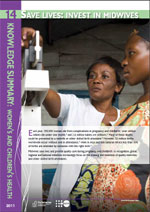
What is the problem?
There are still too few people with midwifery skills
The worldwide shortage of skilled birth attendants has been widely recognized for several years, but the problem persists. In 2010, the Global Strategy for Women’s and Children’s Health noted that an additional 3.5 million health workers were required to improve the health of women and children substantially in the 49 lowest-income countries. In 2006, the World Health Report estimated the global shortage at 4.3 million. In 2005, WHO said an additional 334,000 midwives would be needed over 10 years to achieve 72% coverage of skilled birth attendance in 75 countries. WHO recommends one skilled birth attendant for every 175 pregnant women, but countries like Rwanda have only 1 midwife per 8,600 births. The global shortage of midwives is compounded by inequitable and inefficient distribution. Although most people in developing countries live in rural areas, most of their health workers are located in urban areas.
Recruitment, training and retention are inadequate
Shortages in skilled birth attendants are triggered by a number of factors, including lack of institutional and practical training and varying standards in midwifery education. Poor absorption into the workforce and ineffective regulation compromise service quality. Finally, poor working conditions, remuneration, support and supervision, and lack of career path, make it difficult to retain midwives, especially in rural areas.
Weak health systems hamper midwives
The MNCH Consensus notes that skilled and properly equipped birth attendants save lives. However, midwives often have to work without adequate equipment and medicines in inappropriate facilities, without the required professional support. Additionally, many countries do not have functional health information systems and/or lack health data to support effective workforce planning.
>Download this resource to continue readng